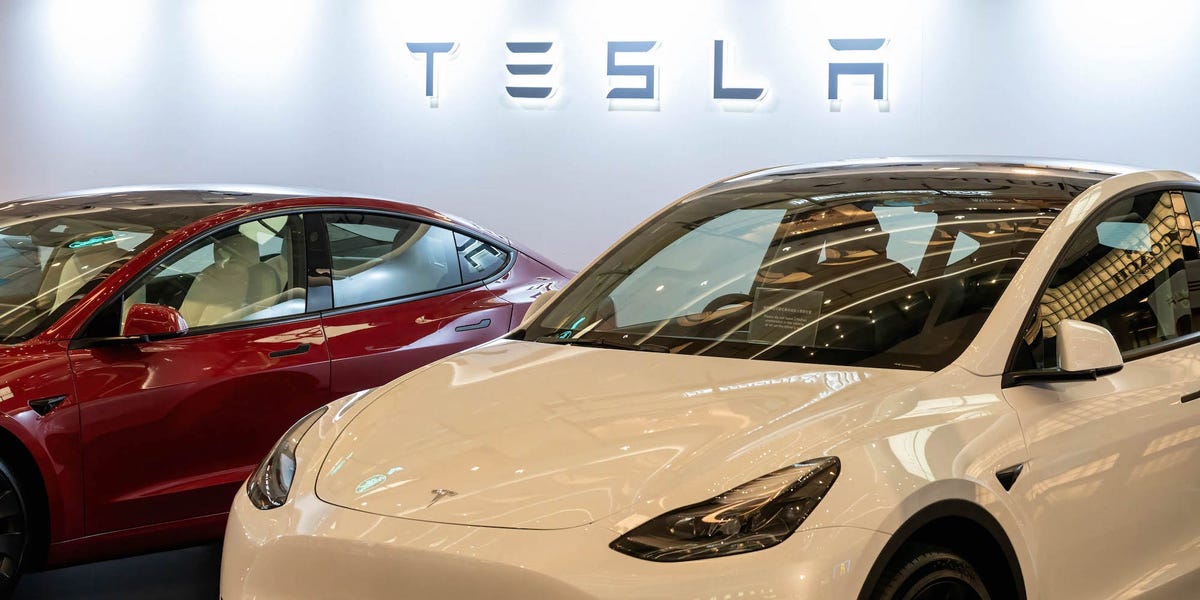Tesla was so swamped with complaints about driving ranges that it created a secret team to cancel owners’ service appointments, source says::To suppress the volume of complaints the automaker created a secret “Diversion Team” in Las Vegas to cancel appointments, Reuters reported.
Instead of displaying the true driving range, the software provided a “rosy” projection of how far cars could drive before needing to be recharged, the report said. The distance EVs can travel before needing to be recharged is one of the main disadvantages the cars face in comparison with gas vehicles. The order to inflate the driving range displayed on the cars was given by Tesla’s CEO Elon Musk around 10 years ago, according to Reuters.
If you know the true answer, but you give your customer a false answer to make your product look better than it is, there’s a word for that. It’s “fraud”.
Counterpoint: Ive taken numerous road trips in both of our family’s Tesla (Tesli?) as well as a couple loaners, and the built in navigation is always spot on with the estimates. Like it’s eerie how it can predict within a percentage point on a 2 hour or more drive within the first 10 minutes of a trip.
Range anxiety really is only experienced by those that it doesn’t affect (i.e. potential buyers)
Removed by mod
In my experience, I tend to get probably 250-ish miles on a 320 mile charge,
That’s a 28% exaggeration in economy.
You’re putting a certain amount of electricity into that car, and you are being told that amount of electricity is good for 320 miles. You’re only getting 250 miles from that. Everyone else is only getting 250 miles from that. The only people supposedly getting 320 miles of range from that charge are the salespeople convincing you to buy it. Misrepresentation of the distance you can travel on a battery is no different than misrepresentation of the distance you can travel on a tank. You’re just multiplying the MPG by the size of the tank, or the kWh/mile by the battery capacity.
Suppose I buy a sedan with a rating of 32mpg. But I’m only getting 25mpg. I put 10 gallons in the 10-gallon tank, expecting to drive 320 miles, but I have to stop and put another 10 gallons in after 250 miles.
Everyone else who bought the same sedan is getting 25mpg. Meanwhile, my other car, an SUV from a different manufacturer, is also rated 32mpg, and actually gets 32mpg. Everyone else who bought that SUV is reporting pretty damn close to 32mpg.
Clearly, the manufacturer of this sedan is pulling something shady. It doesn’t become less shady when the sedan is burning gallons of diesel instead of gallons of gasoline. Or gallons of propane instead of gas or diesel. Or cubic feet of natural gas or hydrogen instead of a liquid fuel. Or pounds of steam instead of a combustible fuel. It doesn’t become less shady when the sedan is consuming kWh of electricity instead of a mass or volume of a physical substance.
The problem is that other vehicles adjust the projection based on current conditions - when I drive up a mountain, my projected range drops like a rock. When I drive back down I can end up with more range than I started. Reporting the “ideal” case during operation is misleading at best.
Yeah, it seems like using ‘miles’ as an indicator or energy left is the root cause. If they just change the kwh left or similar they’d be more accurate but, ironically, confuse way more people.
Though, ironically a scale of Full - 3/4 - half - 1/4 - empty is perfectly fine for gas. There is usually a visual gauge of % for charge, but it isn’t as prominent as the range. Oddly, my car has it divided roughly in thirds.
Removed by mod
You can display percent instead of rated miles
Counter counter point: if the Tesla is doing fraud with the range estimate there is no need to estimate anything that precisely. Just make the software show the same number as guessed when you arrive let’s say you end up with 86 km left as “estimated” at the end of the trip but in reality it’s more like 42 km and the Tesla just shows something else.
Except that is really falsifiable. I pull data with TeslaFi and there’s definitely no shenanigans being done.
The simplest explanation is that it’s impossible to say (miles left) when you consume significantly more power going faster, going uphill, on a very hot day, etc. So they just go with the epa estimate based on your % state of charge and that’s it.
If you want detailed info the car will quickly give it to you and consider all those factors if you put in a destination
The gauge shows epa range available given battery SoC. Once a destination is entered it gives you an accurate estimate in the gps directions.
It can’t guess anything until it knows where you’re going.
Not sure why you’re being down voted. This has been my experience as well.
The remaining battery estimate given at the beginning of the trip is fairly accurate.
I believe it would be Teslae.
I believe it’s actually Teslapodae since it’s from the Greek
Yes, if the projected range is more optimistic than reality, it’s always because I drive faster than 120-130 kph. Otherwise it’s absolutely spot on or even better than projected, for example if I drive 100-110 kph for a while.
In Europe the manufacturers are legally bound to quote the WLTP range. Which is hopelessly inaccurate… But nowhere near as bad as the NEDC that preceded it. Of course people still come on forums wondering why they don’t get <50% more than actually possible> out of their car, and I don’t blame them… the law is an ass.
TBF to Tesla though the in-car estimate is (I think) EPA and isn’t far off… It’s doable in summer, at least. Winter you’ll lose 30% but that’s normal for all cars.
Many manufacturers get around this by quoting an estimated range and then the WLTP in small print ie. Highway Range: Est 415km in normal conditions (600km on WLTP cycle)
Hasn’t it been proven that the range can go longer but Tesla caps it? I remember during a hurricane Tesla said it was extending the range so drivers can make it out.
That’s not he projected range shown on the display. That’s the actual range the battery will give you.
They temporarily removed a bit of the safety margin built in to reduce battery wear, allowing people to get out of harms way without a stop to charge if they were on the limit. But only for people moving away from The affected area, etc. so smart and helpful.
Ah okay, thank you for the additional info.
I dislike both Tesla and Musk but as an automotive company I’d wager they have good safety factors on at least most of their engineering, so for example in the name of keeping the battery from degrading too fast the tesla probably stops drawing power from the battery when the battery voltage drops to a certian number. The safety factor just means that the number it shuts off at is likely a good bit before the batrery would theoretically start to take damage.
I can’t find any other reason they would intentionally keep range off the product, because its not like they selling a solution to it. So I assume they probably just lowered the voltage at which the Tesla stops drawing power because getting stuck in the hurricane was obviously more dangerous. I could be wrong though, this is just from my expirences with bateries in engineering applications.
I think that would be “Teslae” 😉
Huh, I have a Niro EV and it tries pretty hard to extrapolate the range based on the current conditions, so for example if it’s colder outside than the range is less (because it needs to keep the batteries warm), and if you switch on air conditioning or the heater then it immediately lowers the range to account for the extra drain. Occasionally it gets the range prediction wrong, but it really does seem to try to do its best. I just assumed that all EVs work this way.
Niro is from Nissan though. Most reputable manufacturers do produce pretty solid EVs. Tesla is a scam.
Kia makes the Niro, not Nissan.
Ah right. Kia is also more reputable though.
Tesla doesn’t really offer anything to the EV market that other more established makers don’t. Except for poor build quality, panel gaps, and a memelord of a CEO.
In fairness, I am also jealous of their Supercharger network, having had some bad experiences on the very few occasions when I’ve needed a DC fast charge and it seemed like nothing around was working. I hope that it gets upgraded to support CCS in at least some locations so I can start being able to use them.
The superchargers are also stupid, but more so in a regulatory sense. If EVs are to be viable they ought have standardised connectors and methods of charging. Having a private company own that is beyond idiotic.
It is perfectly fine as long as they release the standard and make it unencumbered by licensing, which Tesla has done for NACS. Many standards originally came from companies.
Driving 120km/h on the highway, upwind, uphill, airco usage all decrease your battery more than driving in ideal conditions.
The WLTP is a scam number because ( the way I see it ) it’s how far your car can drive on a perfectly straight piece of road with a slight breeze from behind in the perfect temperature. Conditions which are never met in real life.
In my old diesel car the usage between 120 and 90 km/h on a highway was neglectable. It’s the difference between 5.5/100km and 5.7l/100km.
Driving 90km/h on a highway vs 120 will probably easily make 100km range difference in a Tesla…
There’s a button on the Tesla where you fan see the estimated range based on your current power usage as well as what you’re losing power too ( acceleration/wind/uphill/… ).
I’m not defending it. It’s just not as straightforward because it depends on more than your petrol car.
Tesla model 3 long-range has a WLTP of ~600km. I think the furthest I’d give it is 450-500 in summer and ~ 400-450 in winter ( on a 100% charge). Normally you’d only charge it to 90% to increase battery lifetime unless you’re going on long trips.
Not to mention the power your car loses just standing on your porch…
It’s a trade-off though. My Volvo XC90 does great on the highway, but gets its range completely destroyed by stop-start traffic in the city.
Whereas my Tesla Model Y’s range seems to actually increase when stuck in traffic or even just driving in the city.
Yeah… EVs are totally built for stop-and-go traffic or city driving. For those uninitiated, everytime you slow down with a ICE car, all that kinetic energy is just being turned into heat on your break pads. Meanwhile for an EV car, that energy is then converted back into electricity to charge the battery - this is the same reason why Hybrids have so much better fuel economy. Adding to that, an ICE engine is only ~30% efficient in converting the energy in gasoline to energy for moving the car (the rest being turned into heat, vibrations, noise) whereas an EV is about ~70-80% efficient. You might not go as far while highway driving an EV, but it took a lot less chemical energy to take you there, meter for meter.
Also the efficiency and torque curve of an electric motor is pretty much flat at all speeds, whilst ICE motors are less efficient at both lower RPM (it’s not even speed, it’s rotations per minute) and higher RPM and there’s a sweet spot somewhere in the middle, whose precise position depends on the motor technology (higher for gas, lower for diesel, for example).
The torque also depends on RPM, which is actually why you have gearboxes and those values are in RPM not speed (as the gearbox alters the RPM to speed ratio, exactly to make up for lower torque at higher RPM).
Along with regenerative breaking as you mentioned, this flatter efficiency curve makes EVs much more efficient in stop-and-go traffic than ICEs whose ideal conditions are to be cruising steadilly at around 2500 RPM (for gas, and it also depends on engine) in the highest gear (so at about 100km/h).
One thing to note is you didn’t notice a range difference based on speed because you’re dealing with larger numbers in terms all around, but you definitely had the same efficiency loss in percent when going faster
Won’t someone think of the empty tunnel in Vegas? :(
Sorry for party pooping the Tesla hate train, but the milage estimate when navigation is of is directly correlated to battery state of charge. Its basicly just SoC x factor. Its not dynamic, as in a Kia or BMW. The factor is calculated from officoal EPA range test. Should it be dynamic? Maybe, but you get a true estimate when you navigate to a destination anyway. This is probably done so they could market the car with certain range, same as many other manufacturers.
This is demonstrably false. If you get a brand new Tesla and charge it to 100%, the range on the screen will be the EPA range. That’s not a “rosy” prediction, that’s the prediction that companies must legally use in their sales material in the US.
Also, the BI article says this was 10 years ago, but the Reuters article opens talking about the Model 3, which was only released 5 years ago. But it’s coming from an unnamed source who claims it was a decade ago - not exactly reliable.





